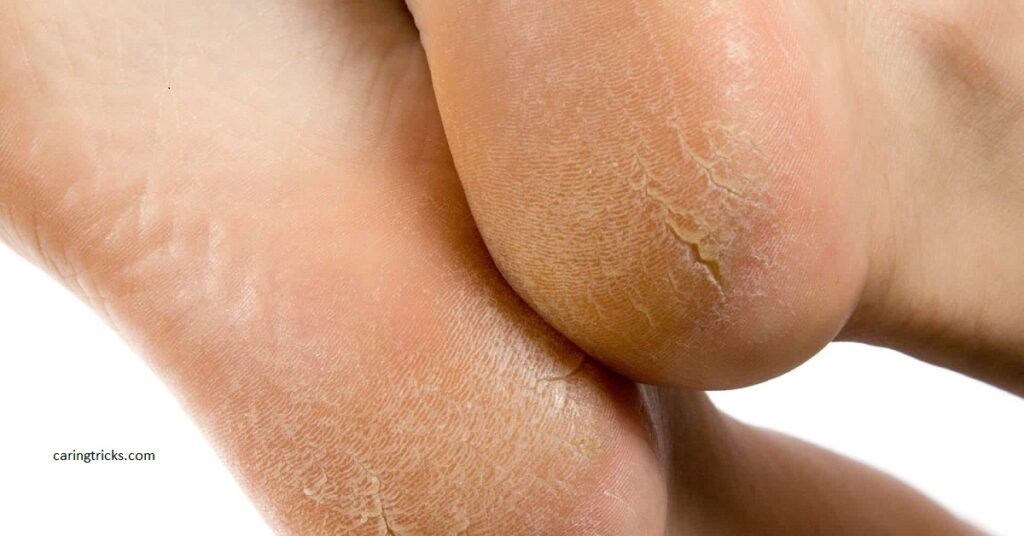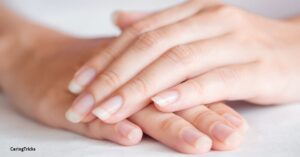How Do You Get Rid of Dirty Cracked Heels?

Fissures, which are often referred to as cracked heels, can occasionally cause more significant issues if left untreated. Your heel’s skin may split if it becomes dry and stiff. The skin may also begin to peel or crust over. When the skin becomes too dry, cracks or fissures may develop.
People may develop dry, cracked heels for several causes. Our feet endure a great deal of strain since they are responsible for supporting our body. The skin on the heel of our feet swells outwards under pressure and weight. When our skin is dry, it becomes less elastic and more rigid, which makes it more susceptible to cracking and fissures.
Reasons of cracked heels:
Heel cracks frequently begin little but can get larger and deeper with time. Your heel fissures may bleed and hurt throughout this time. When you sit down and take your pressure off your feet, the discomfort typically goes away.
Heel fissures are typically brought on by very dry skin. Heels that are cracked are more common in the winter. Most people who have cracked heels find that the issue is only aesthetic and doesn’t lead to any other issues. On the other hand, persons with extensive fractures could feel agony or even bleed.
Even though anybody can get heel fissures, there are several factors that increase their likelihood, such as: wearing sandals or other open-heeled shoes; taking hot showers or baths; using harsh soaps; having cold, dry skin; and standing for extended periods of time.
Heel fissures can affect everyone, although certain people are more susceptible. Risk elements and associated ailments include:
Obesity, diabetes, psoriasis, eczema, prolonged standing or walking on hard surfaces, and thyroid issues, Genes, a lack of estrogen, a deficiency vitamins and minerals, peripheral neuropathy, abnormal circulation.
Cracked heel signs and symptoms:
The first indicator of developing a cracking heel is the appearance of dry, hardened, thicker skin around the heel’s rim. A callus is another symptom. Small fissures above the callus are first discernible. These fissures deepen if ignored, and when additional pressure is applied to the heel, standing and walking will eventually become painful. The fractures could be so severe that they start bleeding.
In extreme circumstances, cellulitis can result from infected cracked heels. Treatment for this requires elevating the affected region, removing any dead tissue, and administering antibiotics.
Common signs that a person could experience include:
o Itchy skin
o Flaky skin
o Pain
o Bleeding
o Reddened, swollen skin
o Ulceration Among the severe signs and symptoms a person could experience are:
o Diminished sensation in your heel
o Cellulitis, a disease, Diabetes-related foot ulcer
Treatments for cracked heels:
There are many different ways to treat a dry, cracked heel, including the use of creams, lotions, and moisturizers as well as home treatments and natural cures. Let’s go through the specific types of creams and at-home therapies you may use to cure your cracked foot in more depth.
Topical Application:
There are many topical foot treatments for cracked heels available on the market. You may put them straight on your feet to utilize them.
Lotions, creams, and ointments that are hydrating can aid in keeping the skin moisturized. Pay a bit extra attention to your cracking heels by starting by hydrating them at least 2 times every day. To get thick moisturizers, look (Eucerin, Cetaphil, others).
The steps listed below might be used to cure cracked heels:
1) Emollients or humectants:
Emollients hydrate the skin by penetrating and halting water loss. They fill up the spaces left by skin flakes, giving the skin a smooth, supple, and flexible sensation. They aid in lowering cutaneous water loss.
Humectants penetrate the top layer of skin, draw moisture from the atmosphere, and keep it wet. They also aid in boosting the skin’s capacity to hold water.
Humectants may take moisture from the bottom layers of the skin rather than the environment when it is dry. This might cause more generalized skin dehydration. A humectant and an occlusive together may help retain moisture.
2) Apply occlusive moisturizer:
To keep the moisture in, folks can apply a thick coat of an occlusive moisturizer over the top after the humectant or emollient has been fully absorbed. To stop water loss, occlusive create a protective wall on the skin.
Occlusive include wax, Aquaphor, silicone, lanolin, and petroleum jelly. An occlusive moisturizer is necessary for feet that are extremely dry or inflamed, particularly at night and during the colder months.
3) Wear cotton socks to bed:
After applying an occlusive moisturizer to the heel, putting cotton socks may assist to retain moisture in, enable the skin on the heel to breathe, and avoid stains on the bed linens. After carrying out this procedure consistently for a few days, the heel’s skin should soften.
4) Using a keratolytic to skin that is too thick:
The best way to cure a cracked heel is to avoid having one in the first place. This may be accomplished by regularly massaging the feet with a moisturizing lotion to maintain the skin moisturized and supple.
There are specialized heel creams on the market with keratolytic (keratolytic) or humectant (humectant) ingredients like urea, salicylic acid, alpha hydroxy acid, and saccharide isomer ate that may help remove dead skin. They could hurt or irritate you just a little.
5) Gently scraping calluses with a pumice stone:
Before applying moisturizer, gently scrape the callus with a pumice stone to remove some of the thick, hard skin.
6) Applying a liquid bandage:
To lessen discomfort, provide protection, and promote quicker healing, the fissures may be covered with a liquid, gel, or spray bandage.
Natural or at-home treatments for cracked or dry feet:
1) Lime + Sugar:
A regular 5-minute routine you may perform is to take three teaspoons of sugar and two lemon halves.
Application: Till all the sugar granules have dissolved into the skin, immerse the lemon pieces into the sugar and scrub the heels every day. After letting it dry, wash it with water and pat it dry.
2)Apple cider vinegar and lemon juice:
Lemon juice and ACV have anti-inflammatory and acidic characteristic which can exfoliate the skin. By removing the dead skin cells, it will aid in nourishing the skin.
Application: Grate the outer layer of a skin of a fresh lemon using a grater. Turn off the gas after bringing 3 liters of water to a boil in a pan with the grated zest. Hold off until it reaches a mild temperature. Put your feet in the water by a tablespoon of apple cider vinegar for at least 15 to 20 minutes.
3)Almond oil:
2 teaspoons by massaging your foot with these oils (at night). Make sure Vaseline is well absorbed into the crevices of your foot by applying it there.
Application: On a low burner, burn a candle in a pot. Apply the product with caution using a flat brush. Allow this to dry and cool. Cover up and wear cotton socks. Take a night off. The next morning, take off the skin and massage any leftover material into the skin.
4) Banana:
Rich in vitamins A, Vitamin b6, and C, bananas are a great source of moisture for the skin. The inherent moisturizing properties of bananas prevent the epidermis on the foot from dry out and maintain their moisture.
Application: Make a paste by blending two ripe bananas. Since unripe bananas include acid that is unhealthy for the skin, they shouldn’t be consumed. Apply the paste or mixture to the entire foot, giving special attention to the margins and nails. Wash your feet with water after letting it rest for 20 minutes. Perform this every night for a minimum two weeks to reap the most advantages.
5) Honey:
Honey is said to be a natural antibacterial that helps heal damaged feet. It is also an excellent humectant, which keeps the skin wet and prevents dryness. Honey’s calming qualities also aid in skin rejuvenation.
Application: Add 1 cup of honey to a warm water bath. After carefully cleansing them, immerse them in this solution for 20 minutes and massage them. After drying them, moisturize your feet. Do this each night before bed for a few weeks.
6) Vegetable oil:
The skin easily absorbs cooking oils. Vegetable oils are a great source of vitamins A, vitamin D, and vitamin E, which help to regenerate new skin cells and cure cracked heels.
Application: Pat them dry after carefully washing them. Spread a generous layer of vegetable oil evenly across your feet and toes. It is recommended that you wear clean, comfy socks. Do this every night before bed to fix the broken heels.
7) Turmeric-infused licorice:
Glycyrrhizin, a chemical found in licorice powder, possesses anti-inflammatory and antibacterial characteristics that may aid in the battle against skin-infecting germs. Turmeric’s antioxidant characteristics assist to brighten and calm down inflamed, itchy skin, while its antibacterial properties aid in the natural healing of dry skin.
Application: Put one tbsp of licorice powder and two teaspoons of turmeric in a dish. Well combine the two ingredients to create a paste. After using the scrub to massaging your foot for a while, wash it off.
8) Tea tree and olive oils:
Tea tree oil is very effective in cleaning the heels and has antibacterial characteristics. It can reduce inflammation, edema, and redness. Along with olive oil, oil of tea tree is one of the greatest essential oils to apply to cracked heels Olive oil is a powerful natural humectant and moisturizer for dry skin since it contains a range of nutrients, such as vitamin E, K, and antioxidants.
Application: One-fourth cup of olive oil should include 6 – 8 drops of essential oil. Mix well. After dipping your legs in warm water, massage your feet well with this mixture. Cracks will emerge and fade fast.
9) Oatmeal with baking soda:
Oatmeal’s grainy texture makes it a great exfoliating component. It is also utilized in a variety of cosmetic exfoliators to remove dead skin cells from feet in a gentle yet efficient manner. This oatmeal feet scrub can help relieve dry, irritated skin.
Application: Mix together enough water to make a thick paste with two tsp of oatmeal, 1 tsp of baking soda, and two teaspoons of oats. After combining all the ingredients, massage your feet for ten minutes with this paste. After rinsing it off, apply moisturizer.
10) At-home pedicure:
An efficient and pleasant method of getting rid of rough skin cells from the feet and soothing damaged skin is a pedicure.
Use: 1 tablespoon coconut oil, 3 tablespoons sugar, and 1/2 cup papaya pulp.
Process: Combine the papaya pulp, sugar, and 3 tbsp of coconut oil well. Place this scrub in a jar that is airtight. Make sure water doesn’t enter the box while performing this pedicure at home. It’s easy and environmentally friendly.
7 to 14 days if kept chilled.
Papaya is a great scrub to lighten dark skin because it is recognized for its skin-whitening abilities. The fact that you can create this foot scrub in large quantities and save it away for more regular use is a plus!
Coconut oil is a superior anti-bacterial and anti-fungal oil. Besides this, oil would only aid in completely cleaning your feet and nails. Sugar crystals are a gentle way to get rid of debris stuck between your toes and nails as well as dead skin.
There are more components that you may use to create a pedicure at home.
One must use caution:
1) Avoid shaving or peeling your calluses:
It can be very difficult to resist the urge to pick at cracked or peeling heels, yet doing so is unsafe for the well-being of your feet. Never try to trim a callus yourself or manually remove dead skin.
2) Boost Your Water Intake:
Don’t only treat your feet when you have cracked heels; instead, get a glass of water, load it up, and start downing it. Make sure you’re drinking enough water. In dry areas, your skin may lose more water during the day, so being hydrated goes a long way toward preventing or treating dry, cracked skin.
3) Don’t closed-back footwear:
Make sure you have a reliable pair of closed choices to wear when you’re having troubles, even if that’s simply a pair of sneakers. Open-back shoes and sandals can create cracking heels—and make them worse! —so make sure you have them. Wear socks and closed-back shoes to protect the region.
4) Avoid Using Harsh Soaps:
Your feet may suffer from harsh chemical soaps alcohol based and other drying chemicals, especially after just a pedicure where fresh skin is exposed. Whenever possible, choose soaps that are created with organically grown components or with fewer ingredients. If you would rather continue using your normal soaps, be careful to moisturize heavily after your shower to replenish the moisture in your feet.
Conclusion:
Don’t overlook dry, cracked heels since doing so increases the likelihood that they may deepen and get infected. Discuss other treatment choices with your doctor if self-care approaches are ineffective. If cracked heels are a sign of a medical issue, people should never attempt to cure them themselves. They should consult a physician instead.
To avoid the wounds becoming infected, it is crucial to seek a specialist’s guidance if the cracks are serious.





